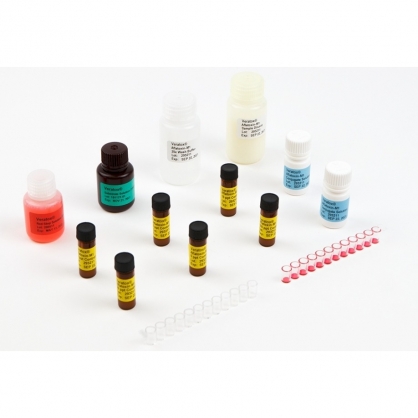- 原理
酵素連結免疫分析法Enzyme-linked immunosorbent assay (ELISA),利用抗原和抗體之間專一性鍵結的特性,並加入顯色酵素和酵素受質,利用顯色的深淺,對檢體進行檢測的分析方法。ELISA可使用標準曲線法 (standard curve) 進行定量,透過檢體的吸光值與標準品進行比對,即可得到檢體的對應濃度。競爭法(competitive ELISA) 一般用於分子量較小的抗原檢測,在抗體數量固定的塑膠孔盤上,加入可鍵結的酵素抗原及檢體抗原,兩種抗原皆會競爭塑膠孔盤上抗體鍵結,當檢體中抗原含量越多,顯色也就越淺
AFLATOXIN M1(黃麴毒素M1),為黃麴毒素B1的羥基化代謝物,可能在牛奶或相關乳製品(例如:嬰兒奶粉)中被發現。當乳牛攝取含有黃麴毒素B1的飼料,瘤胃會對黃麴毒素B1進行吸收,並於肝臟中轉換為黃麴毒素 M1,後續經乳牛代謝後,黃麴毒素M1會存在於乳汁當中。雖然黃麴毒素M1毒性較弱(B1毒性較強),但長期食用含有黃麴毒素M1的乳製品,依舊會造成嚴重的身體危害
- 結果判讀
極限:
偵測極限(limit of detection, LOD): 4.3 ppt
定量極限(limit of quantification, LOQ):5 ppt
偵測範圍:5-100 ppt(樣品超過100ppt需重新稀釋及測量)
- 樣品準備和萃取(SAMPLE PREPARATION AND EXTRACTION)
The sample to be tested should be collected according to accepted sampling techniques (see Neogen’s Food Allergen Handbook). Cheese samples should be ground and thoroughly mixed prior to proceeding with the extraction. Store samples at 2–8°C (35–46°F) until analyzed.
Liquid milk(鮮奶)
1. Centrifuge milk samples to separate fat for 10 minutes at 3500 rpm (2740 x g) at 10°C (50°F). NOTE: If a refrigerated centrifuge is not available, pre-cool the sample in an ice bath for 10–15 minutes.
2. After centrifugation, collect the defatted supernatant (bottom layer).
NOTE: Be sure to avoid collecting the upper fatty layer as this will add an additional matrix to the sample, which could adversely impact the outcome of the assay.
3. The supernatant (skimmed milk) will be used directly in the test (100 μL per well).
NOTE: No dilution factor is used.
Dried milk powders(奶粉)
1. Weigh 10 g of milk powder in a flask. Add 100 mL of distilled water.
2. Stir to dissolve and homogenize.
3. Extract in a rotary shaker for 30 minutes.
NOTE: If whole milk powder is used, continue with steps 4 and 5. If not testing whole milk powder, proceed to step 6.
4. Centrifuge milk samples to separate fat for 10 minutes at 3500 rpm (2740 x g) at 10°C (50°F).
NOTE: If a refrigerated centrifuge is not available, pre-cool the sample in an ice bath for 10–15 minutes.
5. After centrifugation, collect the defatted supernatant (bottom layer).
NOTE: Be sure to avoid collecting the upper fatty layer as this will add an additional matrix to the sample, which could adversely impact the outcome of the assay.
6. The supernatant (skimmed milk) will be used directly in the test (100 μL per well).
NOTE: Because the milk powders were diluted 1:10 during extraction, predicted values need to be multiplied by 10 in order to obtain ppt of aflatoxin M1 per gram of the powdered milk. For example, if the predicted reading is 10 ppt, this refers to the level in reconstituted milk. To calculate the amount in milk powder, multiply by 10:
10 ppt x 10 = 100 ppt/g powdered milk
Cheese(起司)
NOTE: Carefully grate a representative sample. In cheeses with high amounts of external mold, shave off the outer layer prior to sampling, as the mold will hinder the performance of the assay.
1. Weigh out 2 g of finely grated cheese in a 50 cc centrifuge tube.
2. Add 10 mL of 100% dichloromethane.
3. Vortex for 1 minute.
4. Extract in a rotary shaker for 15 minutes.
5. Incubate at 50°C (122°F) for 30 minutes.
6. Centrifuge at 3500 rpm (2740 x g) for 15 minutes at 10°C (50°F).
7. Withdraw 5 mL of the dichloromethane supernatant and place in a glass tube.
8. Evaporate dichloromethane to dryness using a water bath evaporator set at 60°C (140°F) with the use of a nitrogen gas stream to help speed evaporation.
9. Re-dissolve the oily residue in 0.5 mL of 100% methanol and 0.5 mL of distilled water, then add 4 mL of 100% hexanes.
10. Vortex for 1 minute.
11. Centrifuge at 3500 rpm (2740 x g) for 10 minutes at 10°C (50°F).
12. Remove hexanes (upper layer) completely using a Pasteur pipette.
13. Take a 0.5 mL aliquot of the remaining methanol-water layer and dissolve in 2 mL of the sample diluent.
14. Vortex for 1 minute.
15. Use this reconstituted material directly in the test (100 μL per well). NOTE: Because the cheeses were diluted 1:5 during extraction, predicted values need to be multiplied by 5 in order to obtain ppt of aflatoxin M1 per gram of the cheese. For example, if predicted reading is 10 ppt, this refers to the level in cheese. To calculate the amount in cheese, multiply by 5:
10 ppt x 5 = 50 ppt/g cheese
- 操作流程(TEST PROCEDURE)
Allow all reagents to warm to room temperature 8–30°C (64–86°F) before use. All standards and samples will be run in duplicate wells. This will be achieved by transferring standards and samples from 1 red-marked mixing well into 2 antibody-coated microwells.
1. Remove 1 red-marked mixing well for each sample to be tested plus 6 red-marked wells for controls, and place in the well holder.
2. Remove 2 antibody-coated wells per 1 red-marked mixing well to be used. Return antibody wells that will not be used immediately to the foil pack with desiccant. Reseal the foil pack to protect the antibody. Mark one end of strip with a “1” and place strip in the well holder with the marked end on the left. Do not mark the inside or bottom of the wells.
3. Mix each reagent by swirling the reagent bottle prior to use.
4. Using a new pipette tip for each, transfer 250 μL of controls and samples to the red-marked mixing wells as described below.0 5 15 30 60 100 S1 S2 S3 S4 S5 S6 Strip 1
5. Using a 12-channel pipettor, transfer 100 μL from the above mixing wells to the 2 antibodycoated wells as described below.
6. Place the microwell holder on an automatic plate shaker (~600 rpm) and allow continuous shaking for 20 minutes at room temperature (18–30°C, 64–86°F). Discard the red-marked mixing wells.0 5 15 30 60 100 S1 S2 S3 S4 S5 S6 strip 1 0 5 15 30 60 100 S1 S2 S3 S4 S5 S6 strip 2
7. Shake out the contents of the antibody wells. Fill the wells with diluted wash buffer and dump them out. Repeat this step a total of 5 times, then turn the wells upside-down and tap out on a paper towel until the remaining wash buffer has been removed.
8. Pour the needed volume of conjugate from the blue-labeled bottle into the blue-labeled reagent boat.
9. With new tips on the 12-channel pipettor, prime and pipette 100 μL of conjugate into the wells.
10. Place the microwell holder on an automatic plate shaker (~600 rpm) and allow continuous shaking for 10 minutes at room temperature (18–30°C, 64–86°F).
11. Shake out the contents of the antibody wells. Fill the wells with diluted wash buffer and dump them out. Repeat this step a total of 5 times, then turn the wells upside-down and tap out on a paper towel until the remaining wash buffer has been removed.
12. Pour the needed volume of substrate from the green-labeled bottle into the green-labeled reagent boat.
13. With new tips on the 12-channel pipettor, prime and pipette 100 μL of substrate into the wells.
14. Place the microwell holder on an automatic plate shaker (~600 rpm) and allow continuous shaking for 15 minutes at room temperature 18–30°C (64–86°F).
15. Discard remaining substrate and rinse the reagent boat with water.
16. Pour Red Stop Solution from the red-labeled bottle into the red-labeled reagent boat.
17. Eject the excess substrate from the 12-channel pipettor, prime the tips, and pipette 100 μL of Red Stop to each well. Mix by sliding back and forth on a flat surface. Discard the tips.
18. Wipe the bottom of the microwells with a dry cloth or towel and read in a microwell reader using a 650 nm filter. Air bubbles should be eliminated, as they could affect analytical results. Results should be read within 20 minutes after the addition of Red Stop.
19. Read and calculate results using Neogen’s microwell reader, o an equivalent strip reader. If using another strip/plate reader, calculate results using Neogen’s Veratox for Windows® software.
商品特色
商品規格
- 商品規格(96個檢測反應)
1️⃣Microwell holder
2️⃣96 antibody-coated microwells
3️⃣96 red-marked mixing wells
4️⃣6 yellow-labeled bottles of 0, 5, 15, 30, 60, and 100 ppt aflatoxin controls
5️⃣1 bottle of sample diluent
6️⃣1 bottle of 25X wash buffer. Each bottle is enough to prepare 1 L in distilled or deionized water (pH 7.4)
7️⃣2 blue-labeled bottles of aflatoxin-HRP conjugate solution
8️⃣1 green-labeled bottle of K-Blue® Substrate solution
9️⃣1 red-labeled bottle of Red Stop solution

.jpg)
.jpg)

